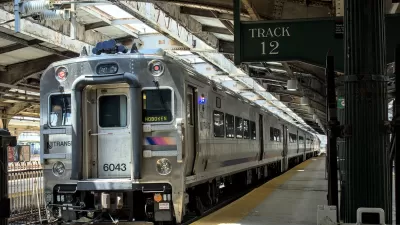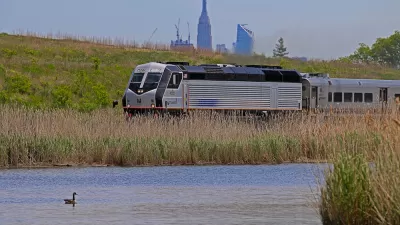It's the nation's shortest commuter route, less than 3 miles with no intermediary stops. The train composed of two electrified cars, with presidential history in its 145 years. If Princeton University has its way, it will soon be replaced by a bus.
Technically know as the Princeton Branch, amongst locals as the Dinky Line for the name of the single Budd Arrow III self-propelled electric coach that connects Princeton University to Princeton Junction, it is up to New Jersey Transit to decide if a bus will replace it.
"The bus makes sense in transportation terms, said Mr. Reed, a former mayor of Princeton borough, but he argued that it would also allow the borough and the university to sidestep their long impasse over the school's planned arts complex. The university wants to move the Dinky station 460 feet farther south to make room for the complex, but the borough is resisting that idea because it would make the station a longer walk from town.
Townspeople keen to preserve the train have flocked to a "Save the Princeton Dinky" Facebook group.
But if these are the Dinky's final days, one might not immediately sense it from riding the train. On a recent weekday morning, most of the seats in the Dinky's one open car were filled with commuters sharing newspapers and conversation."
Correspondent's Notes:
*Do note confuse this line with Florida's 6-mile Dinky Line, 1889-1969.
*Should the university be successful, it will have to shorten its "Mass Transit Travel Options" included on its "Traveling To Princeton" page in its Parents Handbook.
Thanks to NYT Alerts - commuting-transit
FULL STORY: Princeton Journal: Dinky or Bus? A Town Is Torn

Trump Administration Could Effectively End Housing Voucher Program
Federal officials are eyeing major cuts to the Section 8 program that helps millions of low-income households pay rent.

Planetizen Federal Action Tracker
A weekly monitor of how Trump’s orders and actions are impacting planners and planning in America.

Ken Jennings Launches Transit Web Series
The Jeopardy champ wants you to ride public transit.

Washington Legislature Passes Rent Increase Cap
A bill that caps rent increases at 7 percent plus inflation is headed to the governor’s desk.

From Planning to Action: How LA County Is Rethinking Climate Resilience
Chief Sustainability Officer Rita Kampalath outlines the County’s shift from planning to implementation in its climate resilience efforts, emphasizing cross-departmental coordination, updated recovery strategies, and the need for flexible funding.

New Mexico Aging Department Commits to Helping Seniors Age ‘In Place’ and ‘Autonomously’ in New Draft Plan
As New Mexico’s population of seniors continues to grow, the state’s aging department is proposing expanded initiatives to help seniors maintain their autonomy while also supporting family caregivers.
Urban Design for Planners 1: Software Tools
This six-course series explores essential urban design concepts using open source software and equips planners with the tools they need to participate fully in the urban design process.
Planning for Universal Design
Learn the tools for implementing Universal Design in planning regulations.
Heyer Gruel & Associates PA
Ada County Highway District
Institute for Housing and Urban Development Studies (IHS)
City of Grandview
Harvard GSD Executive Education
Toledo-Lucas County Plan Commissions
Salt Lake City
NYU Wagner Graduate School of Public Service




























